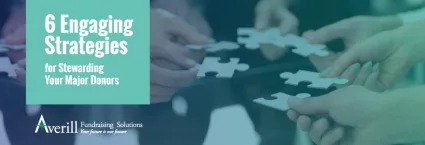
Supporter engagement is a nonprofit’s bread and butter. Without supporters who want to get involved, mission-driven organizations wouldn’t have anyone donating, volunteering, or advocating for their causes. Engaged supporters also spread the word about your nonprofit to their social networks, expanding your reach and boosting fundraising success.
However, many nonprofits see low engagement rates, and it can be difficult for these organizations to pinpoint what they need to do to improve involvement.
These four marketing strategies can help your nonprofit motivate supporters to get engaged:
- Understand your audience.
- Choose the right communication channel.
- Include interactive elements.
- Make marketing messages feel personal.
It can be difficult to know where to begin, especially if your team doesn’t have much marketing experience. For example, should you go with digital marketing or direct mail, or both? The best way to start is to gather and analyze information about your audience.
1. Understand your audience
When you send out marketing messages, your goal should be to ensure that they reach the people who are the most interested in your cause. Getting to know current and prospective donors can help you target the audiences that will be most receptive to your marketing.
If you have large amounts of donor data on hand, diving into that data can be intimidating. To reduce the scale of this data and make sifting through it more manageable, consider segmenting your audience.
Segments are subgroups of your broader audience created around shared characteristics. These characteristics can be anything you deem useful, including:
- Age
- Employment status
- Geographic location
- Household income
- Donation frequency
- Volunteer hours
Once your team creates audience segments, use them to inform how you will market to each subsection of your audience. If you create a segment of supporters with the most volunteer hours, they might be good targets for emails prompting them to get engaged through upcoming volunteer opportunities. On the other hand, if you have a segment of donors who prefer giving monthly donations over volunteering, receiving the same message may not motivate as many of them to sign up to volunteer.
2. Choose the right communication channel
Once you’ve developed a deep understanding of your audience and their demographics and motivations, you can choose the best communication channel to meet their needs.
Ideally, you should send your supporters marketing messages through the channels they already engage with regularly. Feathr’s nonprofit marketing guide outlines some of the most common marketing channels and why your organization should consider using them:
- Email. One of the primary benefits of using email marketing is that it gives your nonprofit a direct line of communication with supporters. Email is a versatile platform that is ideal for sending thank-you messages, sharing success stories, inviting supporters to fundraising events, and soliciting donations. Be sure to set a specific goal for each email you send and direct supporters to the action that will help you meet that goal.
- Social media. With social media, you can easily reach many of your supporters all at once. And with sharing features, your message can quickly reach your followers’ social networks to expand your reach. This channel is best used alongside other outreach efforts to keep awareness of your organization high and remind supporters to get involved.
- Advertisements. In many nonprofit marketing campaigns, organizations neglect to use ads. However, if you notice high bounce rates on your website or an increase in donation form abandonment, ads can help recapture those supporters. Retargeting ads target the people who have visited your website but didn’t complete the desired action, following them to other websites they visit.
- Direct mail. Despite the rise of digital marketing, direct mail is still a viable marketing channel. Direct mail is highly effective for improving brand awareness and recognition among your audience. If your audience is more familiar with your brand and your organization’s goals, they are more likely to get involved.
Keep in mind that while each of these marketing channels has its own unique strengths, they work best when leveraged together in an integrated marketing strategy. Select the channels that meet your nonprofit’s needs, fit your audience’s preferences, and complement one another.
3. Include interactive elements
Interactive marketing is one of the most impactful strategies, with 81% of people saying that interactive content is more effective than static content in marketing messages.
Most interactive content is hosted on digital marketing platforms. Here are a few marketing ideas that you can use to add engaging, interactive elements to your marketing strategy:
- Contests. Motivate your supporters to enter a contest by highlighting an enticing grand prize for the winner. To motivate participants to engage with your nonprofit, ask them to donate or sign up to volunteer with your team to enter the contest. Or, ask them to get creative and design merchandise or flyers for your organization and award the prize to the best entry.
- Polls. Give your supporters a chance to weigh in on the decisions your nonprofit makes. For example, you can ask them to vote between two fundraising ideas to choose your next campaign. Not only does this get your audience engaged in your organization’s decision-making, but it also gives you important insight into which fundraising ideas resonate with them most.
- Quizzes. You can host quizzes on your nonprofit website or social media pages. Get creative with quiz questions, testing your supporters on their knowledge of your cause. At the end of the quiz, you can link any upcoming involvement opportunities or blog posts about the topic.
It can be difficult to make your marketing efforts engaging, especially when your audience already sees so many promotional messages and ads each day. Adding an interactive element motivates your audience to absorb your message, improving their memory and retention of the message.
4. Make marketing messages feel personal
Creating personalized messages is far more effective than mass messaging, which doesn’t take your audience’s unique interests and reasons for giving into account. In fact, 72% of those interviewed say they will only interact with personalized marketing, making it one of the best ways to boost engagement.
One of the easiest ways to customize your messaging is to add a personal touch to promotional emails. You can add your supporters’ names, highlight events and opportunities near their location, or target their reason for contributing to your nonprofit. This can make promotional emails feel more genuine and tailored to their personal reasons for interacting with your nonprofit.
While numbers and statistics can clearly communicate your nonprofit’s impact in a board meeting, they can come off cold and hollow in the context of marketing. As NXUnite’s guide to nonprofit marketing explains, incorporating emotional elements like storytelling is a great way to make your message feel more personal and impactful. Including something like the story of how your nonprofit began and grew to the place it is today can push your audience to engage, as they might feel like they relate to your organization’s struggles and passion for the cause.
Nonprofits can’t accomplish their mission statement alone — supporter engagement is key. With the right nonprofit marketing strategies, your organization can capture your audience’s attention with marketing messages that make them excited about the next opportunity to get involved with your organization.

Guest Author – Aidan Augustin is the co-founder and president of Feathr, an industry-leading tech company building marketing tools specifically tailored to the needs of associations and event organizers. Feathr has helped over 800 associations and 5,000 conferences, trade shows, and virtual events grow attendance, member engagement, and digital sponsorship revenue. Based out of their Gainesville, FL headquarters, Aidan leads the sales and marketing functions of Feathr and spearheads industry engagement. He is an actively involved member of both ASAE and IAEE and a regular speaker on the topics of digital marketing and event/association technology.
When he’s not steering the ship at Feathr, he’s playing strategy games, singing karaoke, or reading books about people who changed the world.



